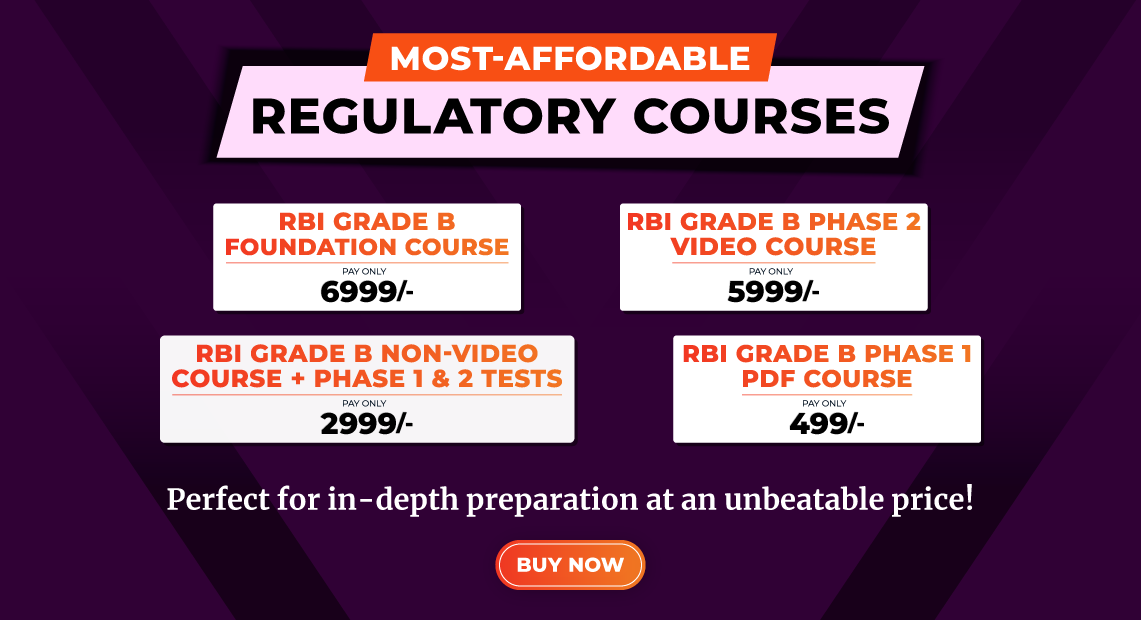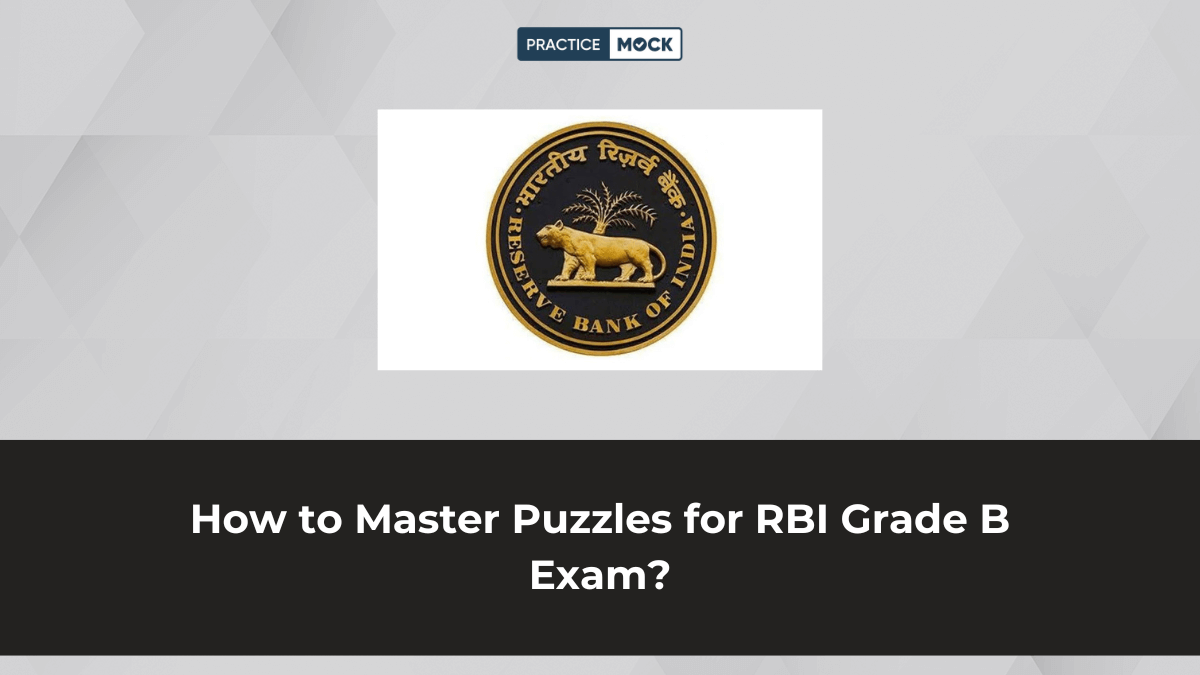Puzzles are a part of the reasoning ability section, which is an Indispensable element of the RBI Grade B Phase 1 exam. Puzzles are a mix of logic, attention to detail, and time management, making them an integral part of the reasoning section. This section carries high weightage. So, mastering puzzles can greatly improve your chances of boosting your overall Reasoning score. In this blog, we will walk through the different types of puzzles that appear in the exam and provide valuable tips to help you face them effectively and successfully.
Types of Puzzles Asked in RBI Grade B Exam
The puzzle questions in RBI Grade B can be categorized into multiple types. So, a good understanding of each category can help you prepare this topic better. Below are the common types of puzzles you can expect in the reasoning part of the upcoming RBI Grade B exam:
- Seating Arrangement Puzzles: These puzzles generally involve people sitting in a circular or linear arrangement. In it, you will be asked to figure out the positions based on certain conditions.
- Blood Relation Puzzles: These puzzles test your ability to understand relationships between family members. You will be given statements and you’ve to base your answer on them.
- Direction Sense Puzzles: These puzzles involve finding directions or locations. These questions will be based on movements or positions.
- Floor and Building Puzzles: In these, you are typically asked to figure out the arrangement of people or objects on different floors of a building.
- Miscellaneous Logical Puzzles: These can range from age-related puzzles to puzzles based on certain conditions. These conditions will require logical deduction.
Tips to Master Puzzles for RBI Grade B 2025 Exam
It’s important to note that puzzles often have a time-bound nature in the RBI Grade B exam. Hence, practicing regularly, polishing your logical thinking, and increasing your speed are the formula for success in puzzle based questions.
Here are some tips to help you master puzzles:
- Understand the Problem Statement: Carefully read the question and identify the conditions given. The ability to quickly grasp the question is essential for solving it in time.
- Draw Diagrams: In many puzzles, visualizing the problem through a diagram or table can make it much easier to understand and solve.
- Start with Simple Questions: Begin by solving easier puzzles to build confidence. Gradually increase the difficulty level as you improve your problem-solving skills.
- Practice Mental Calculations: Some puzzles may require quick mental calculations. Practicing these regularly will reduce your dependence on written calculations.
- Solve Puzzles Under Time Pressure: Since the exam is time-constrained, try solving puzzles within a set time frame to improve your speed.
Sample Questions of RBI Grade B Puzzles
- Seating Arrangement Puzzle: Five friends—A, B, C, D, and E—are sitting in a row. A is to the immediate left of C. D is sitting to the immediate right of B. E is not sitting next to A. Who is sitting at the extreme left?
- Blood Relation Puzzle: Pointing to a photograph, M says, “She is the daughter of the only son of my grandfather.” How is M related to the woman in the photograph?
- Direction Sense Puzzle: A person walks 10 meters north, then turns to the left and walks 10 meters. He turns to the left again and walks 10 meters. Finally, he turns left and walks 10 meters. In which direction is he now from the starting point?
- Floor Puzzle: In a 5-floor building, each floor has one person. The person on the 4th floor is younger than the person on the 5th floor, but older than the person on the 3rd floor. The person on the 2nd floor is younger than the person on the 3rd floor. The person on the 1st floor is the oldest. Who is on the 2nd floor?
- Logical Puzzle: There are five people in a room. A, B, C, D, and E. A is taller than B but shorter than C. D is taller than E. E is shorter than B. Who is the tallest?
Important Question of Puzzles for RBI Grade B
Here are the 5 important puzzle questions with solutions:
Directions 1-5: Answer the following questions based on the information given below:
Seven persons, P, Q, R, S, T, U, and V, work in different offices among IBM, Facebook, Grofers, Infosys, TCS, Google, and Flipkart, but not necessarily in the same order. Each of them goes to the office at a different time among 7:15 am, 8:00 am, 8:30 am, 9:30 am, 11:00 am, and 11:45 am. The timing of one person is not known. Nobody comes before 7:00 am or after 12 noon.
- Q works at Google.
- P works in TCS at 8:30 am.
- U go to the office at 7:15 am but not to Flipkart.
- The difference in the timings of Q and the one who works in IBM is 45 minutes.
- V does not go to the office after 11:00 am.
- Neither R nor S works in IBM or Facebook.
- Nobody goes to the office at 9:00 am.
- The timing of the person who works at Facebook is not known.
- The one who works in Infosys goes after the one who works in Flipkart.
- There is a difference of at least 3 hours between S’s and V’s timing.
Common Solution:
Now, Q works in Google. P works in TCS at 8:30 am. U go to the office at 7:15 am but not in Flipkart. The difference in the timings of Q and the one who works in IBM is 45 minutes. V does not go to the office after 11:00 am. So, either V or T works in IBM.
Question 1: Who among the following works at Flipkart?
a. T
b. S
c. Q
d. P
e. None of these
Answer: b
Solution:
S works in Flipkart. Hence, option b.
Question 2: When does T go to the office?
a. 7:15 am
b. 11:45am
c. 9:30 am
d. 8:30am
e. Cannot be determined
Answer: e
Solution:
The timing of T is not known. Hence, option e.
Question 3: Who among the following works in Infosys?
a. Q
b. R
c. S
d. V
e. None of these
Answer: b
Solution:
R works in Infosys. Hence, option b.
Question 4: Who goes to the office at 11:45 am?
a. Q
b. R
c. T
d. S
e. None of the
Answer: a
Solution:
Q goes to the office at 11:45 am. Hence, option a.
Question 5: When does the one who works at Grofers go to the office?
a. 7:15 am
b. 11:45 am
c. 9:30 am
d. 8:30 am
e. Cannot be determined
Answer: a
Solution:
U goes to the office at 7:15 am. Hence, option a.
Let me know if you’d like more questions or further assistance!

Takeaway
To master puzzles for the RBI Grade B exam, consistent practice and efficient strategies are key. Familiarize yourself with different puzzle types, practice solving them under timed conditions, and always aim to improve both your speed and accuracy. By following the right approach, you can confidently tackle puzzles and score well in the reasoning section.
- Sign Up on Practicemock for Updated Current Affairs, Free Topic Tests and Free Mini Mocks
- Sign Up Here to Download Free Study Material
Free Mock Tests for the Upcoming Exams
- IBPS PO Free Mock Test
- RBI Grade B Free Mock Test
- IBPS SO Free Mock Test
- NABARD Grade A Free Mock Test
- SSC CGL Free Mock Test
- IBPS Clerk Free Mock Test
- IBPS RRB PO Free Mock Test
- IBPS RRB Clerk Free Mock Test
- RRB NTPC Free Mock Test
- SSC MTS Free Mock Test
- SSC Strenographer Free Mock Test
- GATE Mechanical Free Mock Test
- GATE Civil Free Mock Test
- RRB ALP Free Mock Test
- SSC CPO Free Mock Test
- AFCAT Free Mock Test
- SEBI Grade A Free Mock Test
- IFSCA Grade A Free Mock Test
- RRB JE Free Mock Test
- Free Banking Live Test
- Free SSC Live Test



